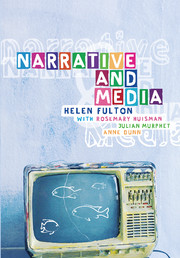Book contents
- Frontmatter
- Contents
- Figures and tables
- Contributors
- Acknowledgements
- 1 Introduction: the power of narrative
- Part 1 The basics of narrative theory
- Part 2 Film as narrative and visual mode
- Part 3 Television: narratives and ideology
- Part 4 Radio and print journalism
- 14 Structures of radio drama
- 15 Radio news and interviews
- 16 Print news as narrative
- 17 Analysing the discourse of news
- Part 5 Popular print culture
- Glossary
- Bibliography
- Index
17 - Analysing the discourse of news
Published online by Cambridge University Press: 05 June 2012
- Frontmatter
- Contents
- Figures and tables
- Contributors
- Acknowledgements
- 1 Introduction: the power of narrative
- Part 1 The basics of narrative theory
- Part 2 Film as narrative and visual mode
- Part 3 Television: narratives and ideology
- Part 4 Radio and print journalism
- 14 Structures of radio drama
- 15 Radio news and interviews
- 16 Print news as narrative
- 17 Analysing the discourse of news
- Part 5 Popular print culture
- Glossary
- Bibliography
- Index
Summary
In the last chapter, I described some of the main features of print news construction that work to bring the genre of news into the broader textual category of narrative. The chapter also raised some of the ideological consequences of the production and consumption of news as narrative.
In this chapter, I outline some strategies for analysing the discourse of print news. Like any kind of critical text analysis, interpretation of news discourse needs to be grounded in an understanding of how language choices in a given context construct particular meanings. This is in fact what discourse means: language choices related to a specific social context, or, as Norman Fairclough defines it, ‘language as a form of social practice’ (Fairclough 1989: 20).
Although most of us can describe in general terms the difference between an ‘objective’ news story and a sensationalised human interest story, accounting for those differences requires a reasonably sophisticated toolbox of linguistic and interpretive concepts that can be applied to different kinds of texts. A semiotic methodology of critical analysis enables us to show how meanings are made and ideologies are reiterated. Systematically identifying specific linguistic choices and their semiotic potential is also effective for calibrating the differences between various genres of news narratives.
Some basic tools for text analysis, based on the work of Michael Halliday and his theory of language as a ‘social semiotic’, have already been introduced and applied in this book (see especially chapters 8 and 12).
- Type
- Chapter
- Information
- Narrative and Media , pp. 245 - 268Publisher: Cambridge University PressPrint publication year: 2005



